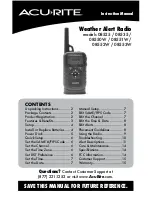
t X 3 3 4 0
i n s t r u c t i o n m A n uA l
PA G E 3
INTrOdUCTION
your GmE tX3340 80 channel is Australian designed and built
and is the most advanced uhF citizen Band radio available.
the tX3340 combines the very latest in electronic hardware
with the most up-to-date computer aided design and
manufacturing techniques to produce an extremely compact
mobile radio with outstanding specifications and performance.
the tX3340 with its controller microphone is designed for
unobtrusive mounting in modern vehicles. the radio case
with its built-in loud speaker and extremely small size can be
mounted in almost any convenient location.
NOTE:
the citizens radio service is licenced in Australia by
AcmA radiocommunications (citizens Band radio stations)
class licence and in new Zealand by mEd General user radio
licence for citizens Band radio and operation is subject to
conditions contained in those licences.
IMPOrTANT INFOrMATION
CONCErNING 80 CH UHF CB rAdIO
the use of the citizen Band radio service is licensed in Australia
by the AcmA radio communications (citizens Band radio
stations) class licence and in new Zealand by the ministry of
Economic development new Zealand (mEd). A General user
radio licence for citizens Band radio and operation is subject to
conditions contained in those licences.
the class licence for users and equipment operating in the cB/Prs
477 mhz band has been amended. this radio meets the new 80
channel standard.
in simple terms the same amount of spectrum is available;
however, radio transceivers can now operate in a narrower
bandwidth and hence use less spectrum. these radios are
generally referred to as narrowband or 12.5 khz radios. By using
12.5 khz channel spacing instead of 25 khz, the 40 channels
originally allocated can now be expanded to 80 channels thereby
doubling the channel capacity and relieving congestion in the uhF
cB/Prs band.
original 40 channel wideband radios will continue to operate on
the original 40 channels, however they will not be able to converse
on the newer channels 41 – 80. the newer narrowband radios will
be able to converse with all older 40 channel wideband radios on all
channels 1 to 40 as well as the newer channels allocated from
41 to 80.
the mixing of narrowband and wideband radios in the same
spectrum can cause some possible operating issues of interference
and varying levels of received volume.
Possible issues
When a new narrowband radio receives a transmission from an
older wideband radio the speech may sound loud and distorted
- simply adjust your radio volume for best performance.
When an older wideband radio receives a signal from a new
narrowband radio, the speech may sound quiet - simply adjust
your radio volume for best performance.
depending on how close your receiving radio is to another
transmitting radio, there can be interference from the
transmitting radio if it is using a channel adjacent to the
channel you are listening to. simply try going up or down a
few channels from the currently selected channel. the above
situations are not a fault of the radio but a symptom of
operating wideband and narrowband radios in the same
bandwidth. this possible interference will decrease over time as
the population of wideband radios ages and decreases.
Further information and updates are available from the
Australian communications and media Authority (AcmA) at
www.acma.gov.au and the ministry of Economic development
(mEd), radio spectrum management at: www.rsm.govt.nz
ACCESSOrIES SUPPlIEd
• Main Radio Unit
• Mounting Cradle
• Instruction Manual
• MC520B LCD Microphone
• Microphone Clip
• DC Lead
• Screw Pack
if any items are missing or
damaged, please contact your
retailer or place of purchase
.




































